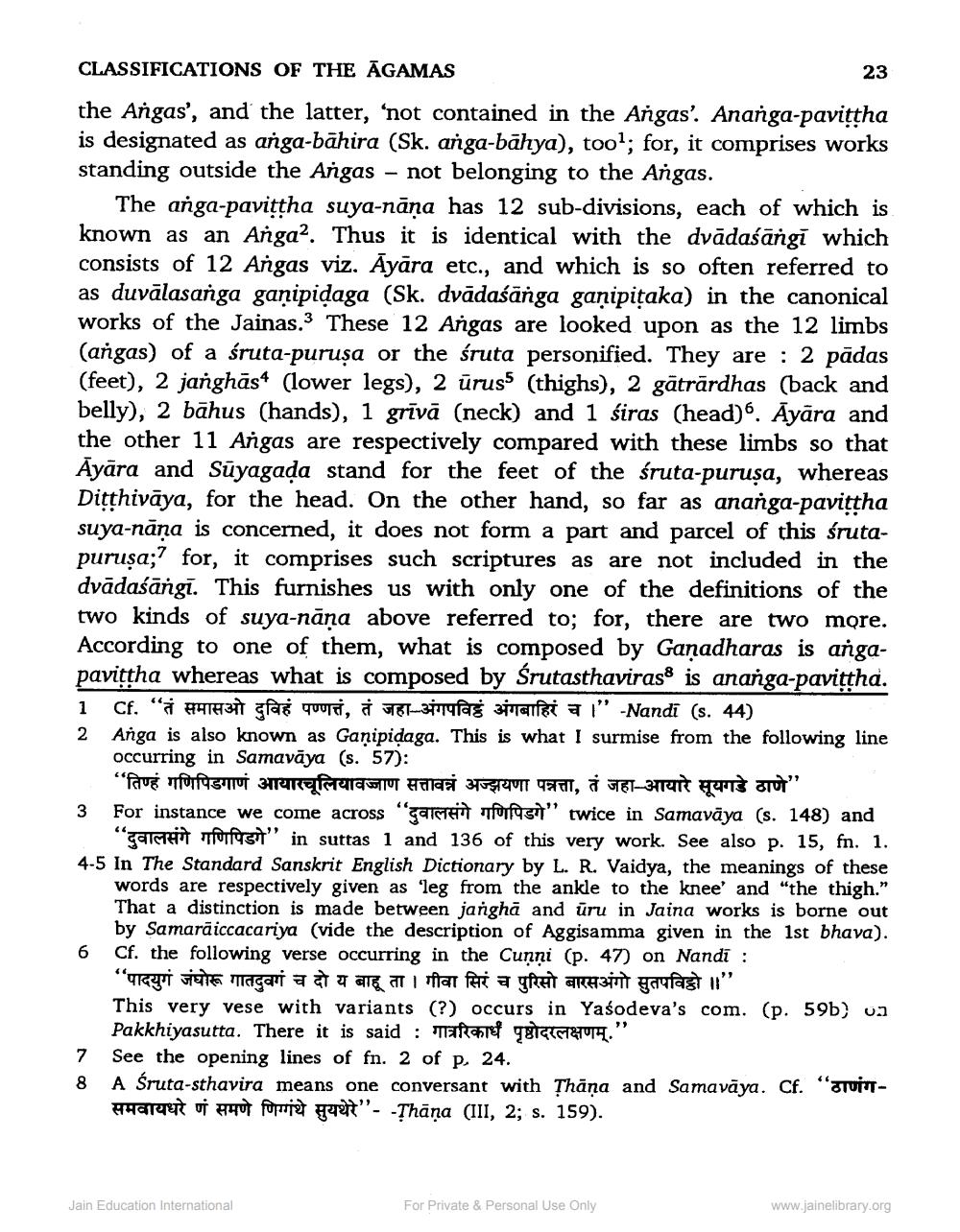________________
CLASSIFICATIONS OF THE AGAMAS
the Angas', and the latter, 'not contained in the Angas'. Ananga-paviṭṭha is designated as anga-bahira (Sk. anga-bāhya), too1; for, it comprises works standing outside the Angas not belonging to the Angas.
-
The anga-paviṭṭha suya-nāņa has 12 sub-divisions, each of which is known as an Anga2. Thus it is identical with the dvādaśāngi which consists of 12 Angas viz. Ayāra etc., and which is so often referred to as duvālasanga ganipiḍaga (Sk. dvādaśānga ganipiṭaka) in the canonical works of the Jainas.3 These 12 Angas are looked upon as the 12 limbs (angas) of a śruta-puruşa or the śruta personified. They are 2 pādas (feet), 2 janghas+ (lower legs), 2 ūrus5 (thighs), 2 gäträrdhas (back and belly), 2 bahus (hands), 1 grīvā (neck) and 1 siras (head)6. Āyāra and the other 11 Angas are respectively compared with these limbs so that Ayara and Suyagaḍa stand for the feet of the śruta-puruşa, whereas Diṭṭhivaya, for the head. On the other hand, so far as ananga-paviṭṭha suya-nāṇa is concerned, it does not form a part and parcel of this śrutapurusa; for, it comprises such scriptures as are not included in the dvādaśāngī. This furnishes us with only one of the definitions of the two kinds of suya-nāņa above referred to; for, there are two more. According to one of them, what is composed by Gaṇadharas is angapaviṭṭha whereas what is composed by Śrutasthaviras is ananga-pavittha. 1 Cf. " तं समासओ दुविहं पण्णत्तं तं जहा - अंगपविट्ठे अंगबाहिरं च ।" - Nandi (s. 44 )
2
3
Anga is also known as Ganipidaga. This is what I surmise from the following line occurring in Samavāya (s. 57):
" तिन्हं गणिपिडगाणं आयारचूलियावज्जाण सत्तावन्नं अज्झयणा पत्रत्ता, तं जहा आयारे सूयगडे ठाणे”
For instance we come across "garen forfast" twice in Samavāya (s. 148) and "galerit morfars" in suttas 1 and 136 of this very work. See also p. 15, fn. 1. 4-5 In The Standard Sanskrit English Dictionary by L. R. Vaidya, the meanings of these
words are respectively given as 'leg from the ankle to the knee' and "the thigh." That a distinction is made between jangha and ūru in Jaina works is borne out by Samaraiccacariya (vide the description of Aggisamma given in the 1st bhava). Cf. the following verse occurring in the Cunni (p. 47) on Nandi : "पादयुगं जंघोरू गातदुवगं च दो य बाहू ता । गीवा सिरं च पुरिसो बारसअंगो सुतपविडो || "
6
This very vese with variants (?) occurs in Yaśodeva's com. (p. 59b) un Pakkhiyasutta. There it is said: makand grewery.'
23
7 See the opening lines of fn. 2 of p. 24.
8
A Śruta-sthavira means one conversant with Thana and Samavāya. Cf. " anet of a forrit geret"--Thana (III, 2; s. 159).
Jain Education International
For Private & Personal Use Only
www.jainelibrary.org




